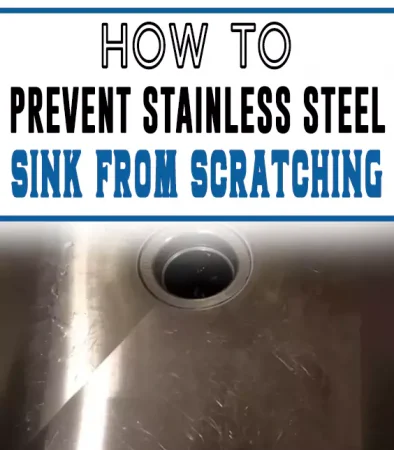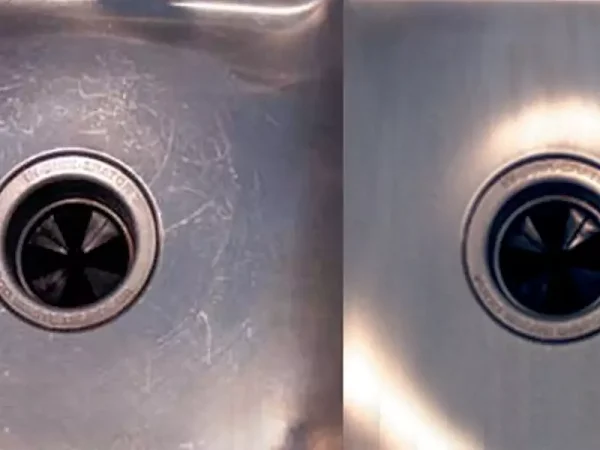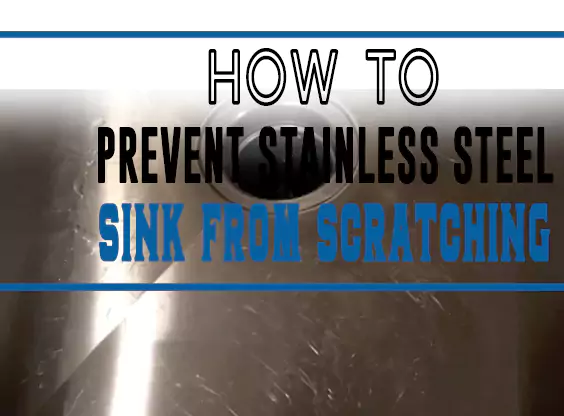A damaged sink can leave you frustrated, but here’s how to stop a stainless steel sink from scratching or prevent it from happening.
Though stainless steel prevents rust and corrosion, sinks can be scratched or stained easily if you aren’t using them carefully.
A stainless steel farmhouse sink can give your kitchen a shine, but once a stainless steel sink is scratched, it’s a bit difficult to remove the scratch.
So, you need to be aware of preventing stainless steel sinks from scratch. By taking preventive measures, you can maintain the shine of your kitchen sink for longer. Before getting into more detail, let’s find out how stainless steel sinks get scratched.

Common Reasons Of Stains And Scratches On Stainless Steel Sink
Firstly, you need to understand what causes the stainless steel sinks to scratch. Once you know the reasons behind the dull and scratchy look of your kitchen sink, you can be careful from the next time not to make these mistakes.
1. Filling the sink with utensils
We often leave dirty utensils in the sink to clean them later. It’s downright rude behavior to stainless steel sinks. The dirt and grime on utensils can stain the sink if you put them on for a long time.
And when you put too many metal utensils in the sink, the friction between them can scratch the sink. These scratches are very difficult to remove.
2. Using abrasive materials and cleaners
Another common practice is using abrasive cleaners to remove stubborn residue from utensils. Though these cleaners are good as cleaning agents, they might diminish the shine of your stainless steel sink.
Cleaning the sink with steel wool or similar abrasive materials is also a great risk. Steel wool or hard bristle brushes can easily scratch steel sinks.
3. Harsh chemicals
Using chemicals like chlorine can damage the look of your steel sink. They also damage the protective coating of the sink, hence causing Oxygen in the air to react with steel and rust the sink.
3. Not cleaning the sink regularly
Sinks take a lot of abuse everyday. If you don’t clean them properly, they will catch a lot of streaks, stains, and scratches. Over time, these threats multiply and ruin the look and protection of the sink surface.
Cleaning in the wrong way is also one of the biggest reasons behind stainless steel sinks scratching.
How to protect stainless steel sink from scratching?
A bit of awareness mixed with regular maintenance can keep your kitchen sink from scratches. Here are several things you can do to prevent scratches and other threats.
1. Keep the sink free from mess
Whenever you need to put something in the sink, clean it as soon as possible and move it away from the sink. A clogged sink is always prone to scratches. Instead of putting dishes to clean later, wash them right after use.
2. Don’t use abrasive cleaners
Abrasive cleaners or harsh chemicals will quickly damage the shine of steel sinks. Don’t use such cleaners to clean the sink. Even if you need such cleaners to wash dishes or utensils, take a separate bowl to clean them and drain the solution as soon as possible.
3. Don’t use steel wool or wire brush
Never use an abrasive brush or scrub to scour the surface of the sink. It will instantly scratch the sink surface. Instead, you can use a soft sponge to clean the sink. If you need a strong scrubber to scrub off any stubborn residue, use mesh or microfiber cloth.
4. Keep the sink dry
Don’t let water sit in the sink for a long time. If water sits for long, it can leave streaks or stains on the sink surface. After using the sink, drain all the used water quickly and give the sink a quick wash. Use a paper towel or dry cloth to wipe off the water.
5. Use metal grids
You can place a grid rack in the sink while cleaning dishes or sharp utensils. As nothing will touch the bottom of the sink, the surface will remain shiny for longer. Some people tend to use rubber mats to keep the sink from scratches.
But it hinders the drainage of wastewater which might cause more damage than benefits. So, using a steel rack will be more suitable.
How To Remove Scratches From Stainless Steel Sink?

If your kitchen sink gets scratched even after taking all preventive measures, we include some DIY techniques here to minimize those scratches. Let’s break the scratches into two categories: light and deep.
For light scratches
- You can buy non-abrasive scratch removers. If those aren’t available, take some non-gel toothpaste or make a paste with baking soda and water.
- Use a soft bristle brush to apply toothpaste on the scratches. Brush them gently for a bit and wipe off extra toothpaste to check the finish.
- In the case of baking soda paste, use a microfiber cloth to buff the scratched surface.
- Once done, check if the shine is restored. Otherwise, repeat the process several times to get your desired outcome.
For deep scratches
- In this case, you need to use scouring pads. To make the pad gentle on the surface, apply some oil to the pad and rub the scratched surface gently in a consistent motion.
- Remember to rub in the direction of the grain. Otherwise, the surface can scratch even more.
- Be persistent while rubbing. Once it is done, check the finish of the surface to determine whether you need to rub more.
Stainless steel sinks have excellent durability and rust resistance. But they are highly susceptible to scratches and stains. One wrong move, and you can ruin the shine of your kitchen sink.
Once you know how to protect stainless steel sinks from scratching, you can avoid common mistakes and take the necessary steps to maintain the shine. Simple steps like regular cleaning and drying can go a long way in preventing scratches.
And the techniques of removing scratches will help you sort any scratch that already happened. Take a bit more care of your stainless steel sink to keep it as it is for years to come.
